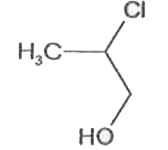The reaction
BrCH2CH2CH2Br+MgEt2O−−→ Product mainly
CH3CH2CH3
BrMgCH2CH2CH2MgBr

CH3=CH=CH2
To solve the question regarding the reaction of 1,3-dibromopropane with magnesium in diethyl ether, we can follow these steps:
Step 1: Identify the Reactants
The reactant given is 1,3-dibromopropane, which has the structure:
Br−CH2−CH2−CH2−Br
This compound contains two bromine atoms attached to the first and third carbon atoms of a three-carbon chain (propane).
Step 2: Understand the Reaction Conditions
The reaction is performed with magnesium (Mg) in the presence of diethyl ether (Et2O). This environment is crucial because diethyl ether acts as a solvent that stabilizes the Grignard reagent formed during the reaction.
Step 3: Formation of Grignard Reagent
When 1,3-dibromopropane reacts with magnesium, a Grignard reagent is formed. The reaction can be represented as:
Br−CH2−CH2−CH2−Br+Mg→Br−CH2−CH2−CH2−MgBr
This reaction leads to the formation of a Grignard reagent, which is a compound where magnesium is bonded to the carbon atom that was previously attached to bromine.
Step 4: Analyze the Structure of the Grignard Reagent
The Grignard reagent formed is:
Br−CH2−CH2−CH2−MgBr
This compound has a nucleophilic carbon (the carbon attached to magnesium) and can react further with electrophiles.
Step 5: Consider Possible Reactions
The Grignard reagent can react with various electrophiles. However, in this case, since we have two bromine atoms, the Grignard reagent can potentially react with itself, leading to a cyclization reaction.
Step 6: Cyclization to Form Cyclopropane
The nucleophilic carbon can attack the electrophilic carbon of the other bromine, leading to the formation of a cyclic compound. The reaction can be summarized as:
Br−CH2−CH2−CH2−MgBr→Cyclo∝a≠+MgBr2
This results in the formation of cyclopropane as the major product and magnesium bromide as a side product.
Conclusion
The main product of the reaction between 1,3-dibromopropane and magnesium in diethyl ether is cyclopropane.
Final Answer
The product mainly formed is cyclopropane.
---
The reactant given is 1,3-dibromopropane, which has the structure:
Br−CH2−CH2−CH2−Br
This compound contains two bromine atoms attached to the first and third carbon atoms of a three-carbon chain (propane).
The reaction is performed with magnesium (Mg) in the presence of diethyl ether (Et2O). This environment is crucial because diethyl ether acts as a solvent that stabilizes the Grignard reagent formed during the reaction.
When 1,3-dibromopropane reacts with magnesium, a Grignard reagent is formed. The reaction can be represented as:
Br−CH2−CH2−CH2−Br+Mg→Br−CH2−CH2−CH2−MgBr
This reaction leads to the formation of a Grignard reagent, which is a compound where magnesium is bonded to the carbon atom that was previously attached to bromine.
The Grignard reagent formed is:
Br−CH2−CH2−CH2−MgBr
This compound has a nucleophilic carbon (the carbon attached to magnesium) and can react further with electrophiles.
The Grignard reagent can react with various electrophiles. However, in this case, since we have two bromine atoms, the Grignard reagent can potentially react with itself, leading to a cyclization reaction.
The nucleophilic carbon can attack the electrophilic carbon of the other bromine, leading to the formation of a cyclic compound. The reaction can be summarized as:
Br−CH2−CH2−CH2−MgBr→Cyclo∝a≠+MgBr2
This results in the formation of cyclopropane as the major product and magnesium bromide as a side product.
The main product of the reaction between 1,3-dibromopropane and magnesium in diethyl ether is cyclopropane.
The product mainly formed is cyclopropane.
Topper's Solved these Questions
- GRIGNARD REAGENTBOOK - MOTIONCHAPTER - GRIGNARD REAGENTEXERCISE - EXERCISE-2
16 Videos
- GRIGNARD REAGENTBOOK - MOTIONCHAPTER - GRIGNARD REAGENTEXERCISE - EXERCISE-2
16 Videos
- GOCBOOK - MOTIONCHAPTER - GOCEXERCISE - Exercise - 4 Level - II
14 Videos
- HYDROCARBON BOOK - MOTIONCHAPTER - HYDROCARBON EXERCISE - Exercise - 4 (Level-II)
15 Videos
Similar Questions
Knowledge Check
CH3−CH2−BrDryAg2O−−−−−→Product of reaction is:
ACH3−CH2−OHBH2C=CH2CCH3−O∣∣C=HDCH3−CH2−O−CH2−CH3CH3−CH2−BrDryAg2O−−−−−→Product of reaction is:
ACH3−CH2−OHBH2C=CH2CCH3−O∣∣C=HDCH3−CH2−O−CH2−CH3Identify 'Z' in the following reaction series,
CH3CH2CH2BrNaOHaqXAl2O2−−−→Δ(Y)HOCl−−−→(Z)A B
B C
C D
D
Condiser the reactions,
(i) (CH3)2CH−CH2BrC2H5OH−−−−→(CH3)2CH−CH2OC2H5+HBr
(ii) (CH3)2CH−CH2BrC2H5O−−−−−−→(CH3)2CH−CH2OC2H5+Br−
The mechanism of reactions (i) and (ii) are respectively :
View SolutionThe final product of the following sequence of reaction is :
(CH3O)2CHCH2CH2CH2BrMg−−→H2C=O−−−−→H3O+−−−−−−→heat
View SolutionCH3CH2CH2CONH2Br2/KOH−−−−−−→Product
The organic product of above reaction is.
View SolutionIn the reaction
BrCH2−CH2Br+Zn→Y+ZnBr2,Y is
View SolutionThe reaction
BrCH2CH2Br+ZnCH3CO2H−−−−−−→CH2=CH2+ZnBr2
proceeds by the …… mechanism.
View Solution


